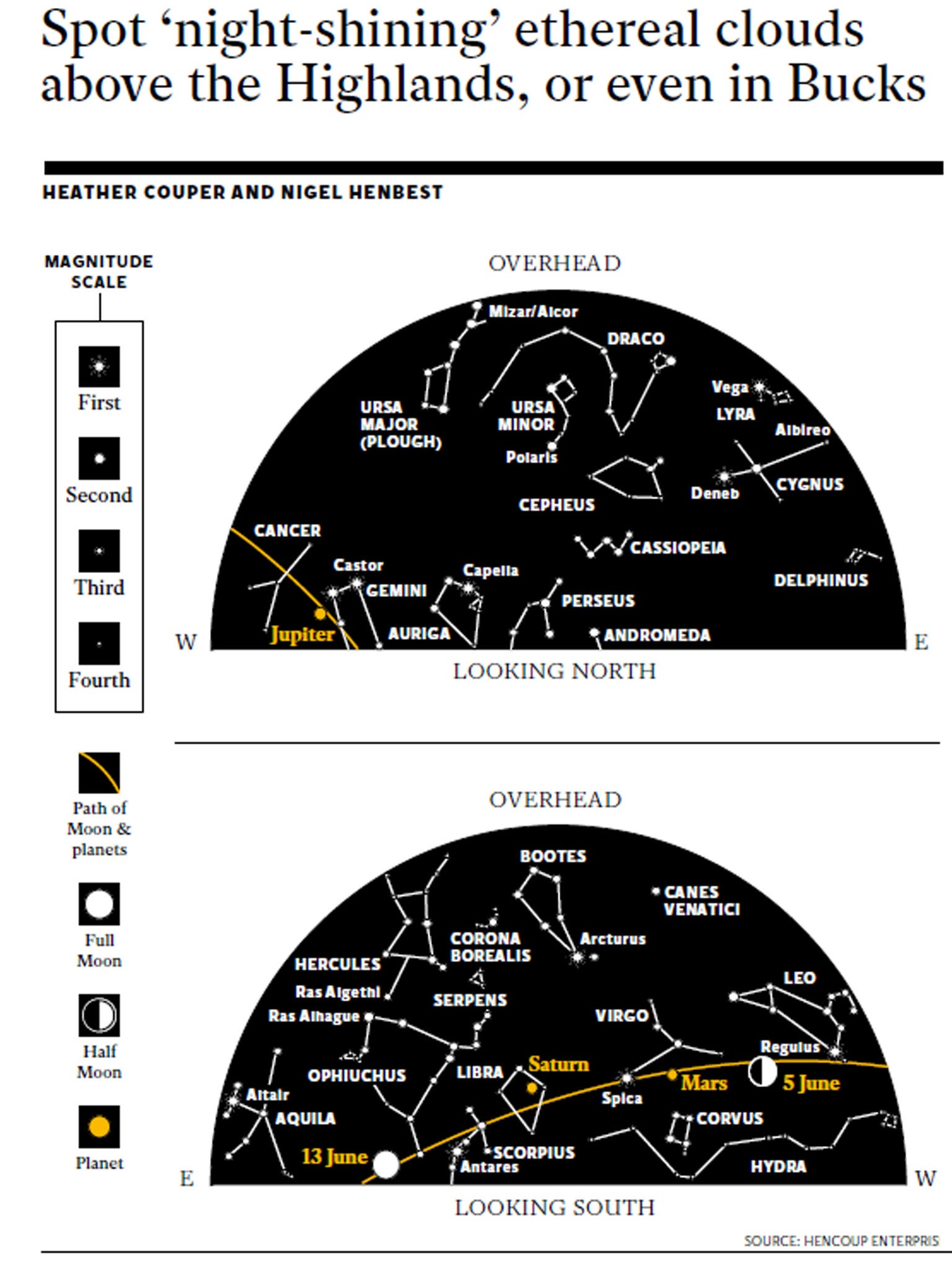Stargazing: Keep your eyes peeled for noctilucent clouds
Spot ‘night-shining’ ethereal clouds above the Highlands, or even in Bucks

Your support helps us to tell the story
From reproductive rights to climate change to Big Tech, The Independent is on the ground when the story is developing. Whether it's investigating the financials of Elon Musk's pro-Trump PAC or producing our latest documentary, 'The A Word', which shines a light on the American women fighting for reproductive rights, we know how important it is to parse out the facts from the messaging.
At such a critical moment in US history, we need reporters on the ground. Your donation allows us to keep sending journalists to speak to both sides of the story.
The Independent is trusted by Americans across the entire political spectrum. And unlike many other quality news outlets, we choose not to lock Americans out of our reporting and analysis with paywalls. We believe quality journalism should be available to everyone, paid for by those who can afford it.
Your support makes all the difference.Heading for Scotland this June? Or perhaps to points further north? Then keep your eyes peeled for one of the ghostliest phenomena in the heavens: noctilucent clouds.
These clouds shine only at night, after all the other clouds have left the skies. Their name literally means “night shining”. Best seen in dark twilight towards the north, they are part of a very high polar cloud layer in the Earth’s upper atmosphere. Like conventional clouds, they are made of water ice – but here’s where the resemblance ends. Noctilucent clouds are the highest clouds hovering above our planet: forming at altitudes of up to over 80km, they touch the edge of space itself.
Early summer is the best time to spot them, because – in northern latitudes – the just-set Sun is at the right angle to light them up. You can’t mistake them for ordinary clouds, not even cirrus. Noctilucent clouds shine with an eerie, bluish, almost electric glow.
Before 1885, there were no records of noctilucent clouds. But two years after the eruption of Krakatoa in 1883, the clouds began to appear. Meteorologists speculated that the clouds could be made of ice coating particles of volcanic dust.

But astronomers were not to be outdone. Could they be due, they wondered, to ice piling up on the millions of tonnes of micro-meteoroids pouring into Earth’s atmosphere each year? And there’s some evidence that clouds visible after the explosion of the Tunguska fireball over Siberia in 1908 were caused by microscopic particles from the event.
Enter the space scientists. They propose that some noctilucent clouds may be created by particles from rocket exhausts. In 2009, the US Naval Research Laboratory launched a sounding rocket to create an artificial noctilucent cloud, which was observed for months.
So – what’s the explanation for these phantoms of the night? The jury is still out – but what’s certain is that sightings are becoming more frequent. One controversial idea puts this down to global warming. Increased greenhouse gas emissions, while warming the Earth, actually make the upper atmosphere colder, so it’s easier for ice crystals to form.
But back to your northern peregrinations. For those of you not enjoying the glorious glens in June, never fret. Noctilucent clouds are occasionally spotted much further south – even in Italy – and we have seen great displays in Buckinghamshire!
WHAT’S UP
Over in the north-west, Jupiter shines brilliant in the dusk twilight. But it’s dropping down towards the Sun, and disappears by the end of the month. We won’t be seeing the giant planet in the evening sky again until November.
Once it grows dark – pretty late at this time of year – you’ll spot a line of five bright objects spread out above the horizon from west through to south. Look carefully, and you’ll make out some startlingly different colours (best seen with binoculars).
Starting from the right, the first is Regulus, the blue-white star that marks the heart of Leo, the celestial lion. Next comes Mars, shining with a steady ochre glow. Just to the left of the Red Planet lies Spica, another blue-white star that’s the jewel in the crown of Virgo, the virgin. Then we have Saturn, a dull yellow “star” to the eye or binoculars, but a glorious ringworld when put under the power of a telescope. Finally, low in the south, you’ll find a red giant star: Antares, the heart of Scorpius (the scorpion). Its name means “the rival of Mars” – which do you find to be the redder?
Above Antares lie two huge but faint celestial heroes. The constellation of Ophiuchus represents a man wrestling with a serpent (Serpens), his head marked by the star Ras Alhague. Higher in the sky, the great superhero Hercules hangs upside-down in the sky, so that his head – Ras Algethi – is intimately close to that of the serpent-bearer.
Finally, if you’re around at 3am, brilliant Venus is rising in the east just before the Sun: the crescent Moon lies nearby on the morning of 24 June.
DIARY
13 June, 5.11am: Full Moon
19 June, 7.39pm: Moon at Last Quarter
21 June, 11.51am: Summer Solstice
27 June, 9.08am: New Moon
Join our commenting forum
Join thought-provoking conversations, follow other Independent readers and see their replies
Comments